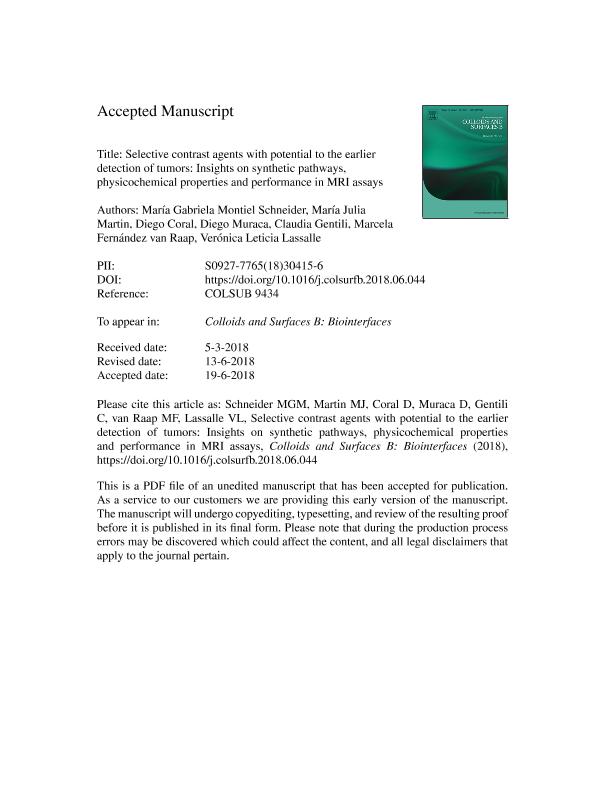Mostrar el registro sencillo del ítem
dc.contributor.author
Montiel Schneider, María Gabriela

dc.contributor.author
Martin, Maria Julia

dc.contributor.author
Coral, Diego Fernando

dc.contributor.author
Muraca, Diego

dc.contributor.author
Gentili, Claudia Rosana

dc.contributor.author
Fernández van Raap, Marcela Beatriz

dc.contributor.author
Lassalle, Verónica Leticia

dc.date.available
2019-10-28T20:15:33Z
dc.date.issued
2018-10-01
dc.identifier.citation
Montiel Schneider, María Gabriela; Martin, Maria Julia; Coral, Diego Fernando; Muraca, Diego; Gentili, Claudia Rosana; et al.; Selective contrast agents with potential to the earlier detection of tumors: Insights on synthetic pathways, physicochemical properties and performance in MRI assays; Elsevier Science; Colloids and Surfaces B: Biointerfaces; 170; 1-10-2018; 470-478
dc.identifier.issn
0927-7765
dc.identifier.uri
http://hdl.handle.net/11336/87426
dc.description.abstract
Magnetic iron oxide nanoparticles (MNPs) have been prepared and stabilized with three organic acids (tartaric, malic and ascorbic) in order to obtain biocompatible and water dispersible MNPs with potential to bind specifically to tumoral cancer cells. An in deep characterization was performed aiming to verify the presence and effect of the coating and stabilizer on MNPs surface. Besides the mechanisms followed by the different acids to bind MNPs were elucidated and used to justify the differences in the physicochemical properties of each formulation. Data related to characterization revealed that MNPs coated with ascorbic acid (MNPs-AA) resulted the most suitable in terms of their size, surface charge and stability along the time. Besides, ascorbic acid may be recognized by GLUTs receptors that are overexpressed in several kinds of tumoral cells. Therefore, MNPs-AA was selected to explore its performance in both MRI and in vitro assays using human colon cancer cells HCT 116. MRI experiments were performed in clinical equipment using a series of aqueous dispersions of MNPs-AA that were evaluated as T2 contrast agent. The T2- weighted images obtained as well as the calculated r2, indicated that MNPs-AA could act as efficient T2 contrast agent for MRI. Regarding in vitro assays, MNPs-AA did not alter the cellular function neither exert cytotoxicity using the three explored doses. The internalization of the nanoparticles on the cellular structure was confirmed quanti and qualitatively using atomic absorption spectroscopy and Prussian blue techniques respectively. From these results, it emerges that ascorbic acid coated-magnetite nanoparticles may be used as alternative contrast agent to avoid or minimize some toxicological issues related to the widely used gadolinium.
dc.format
application/pdf
dc.language.iso
eng
dc.publisher
Elsevier Science

dc.rights
info:eu-repo/semantics/openAccess
dc.rights.uri
https://creativecommons.org/licenses/by-nc-nd/2.5/ar/
dc.subject
ASCORBIC ACID
dc.subject
CONTRAST AGENTS
dc.subject
HUMAN COLON CANCER CELLS
dc.subject
MAGNETITE NANOPARTICLES
dc.subject.classification
Otras Ciencias Químicas

dc.subject.classification
Ciencias Químicas

dc.subject.classification
CIENCIAS NATURALES Y EXACTAS

dc.title
Selective contrast agents with potential to the earlier detection of tumors: Insights on synthetic pathways, physicochemical properties and performance in MRI assays
dc.type
info:eu-repo/semantics/article
dc.type
info:ar-repo/semantics/artículo
dc.type
info:eu-repo/semantics/publishedVersion
dc.date.updated
2019-10-23T21:36:12Z
dc.journal.volume
170
dc.journal.pagination
470-478
dc.journal.pais
Países Bajos

dc.journal.ciudad
Amsterdam
dc.description.fil
Fil: Montiel Schneider, María Gabriela. Consejo Nacional de Investigaciones Científicas y Técnicas. Centro Científico Tecnológico Conicet - Bahía Blanca. Instituto de Química del Sur. Universidad Nacional del Sur. Departamento de Química. Instituto de Química del Sur; Argentina
dc.description.fil
Fil: Martin, Maria Julia. Consejo Nacional de Investigaciones Científicas y Técnicas. Centro Científico Tecnológico Conicet - Bahía Blanca. Instituto de Ciencias Biológicas y Biomédicas del Sur. Universidad Nacional del Sur. Departamento de Biología, Bioquímica y Farmacia. Instituto de Ciencias Biológicas y Biomédicas del Sur; Argentina
dc.description.fil
Fil: Coral, Diego Fernando. Consejo Nacional de Investigaciones Científicas y Técnicas. Centro Científico Tecnológico Conicet - La Plata. Instituto de Física La Plata. Universidad Nacional de La Plata. Facultad de Ciencias Exactas. Instituto de Física La Plata; Argentina. Institución Universitaria CESMAG; Colombia
dc.description.fil
Fil: Muraca, Diego. Universidade Estadual de Campinas; Brasil
dc.description.fil
Fil: Gentili, Claudia Rosana. Consejo Nacional de Investigaciones Científicas y Técnicas. Centro Científico Tecnológico Conicet - Bahía Blanca. Instituto de Ciencias Biológicas y Biomédicas del Sur. Universidad Nacional del Sur. Departamento de Biología, Bioquímica y Farmacia. Instituto de Ciencias Biológicas y Biomédicas del Sur; Argentina
dc.description.fil
Fil: Fernández van Raap, Marcela Beatriz. Consejo Nacional de Investigaciones Científicas y Técnicas. Centro Científico Tecnológico Conicet - La Plata. Instituto de Física La Plata. Universidad Nacional de La Plata. Facultad de Ciencias Exactas. Instituto de Física La Plata; Argentina
dc.description.fil
Fil: Lassalle, Verónica Leticia. Consejo Nacional de Investigaciones Científicas y Técnicas. Centro Científico Tecnológico Conicet - Bahía Blanca. Instituto de Química del Sur. Universidad Nacional del Sur. Departamento de Química. Instituto de Química del Sur; Argentina
dc.journal.title
Colloids and Surfaces B: Biointerfaces

dc.relation.alternativeid
info:eu-repo/semantics/altIdentifier/url/https://www.sciencedirect.com/science/article/pii/S0927776518304156
dc.relation.alternativeid
info:eu-repo/semantics/altIdentifier/doi/http://dx.doi.org/10.1016/j.colsurfb.2018.06.044
Archivos asociados
